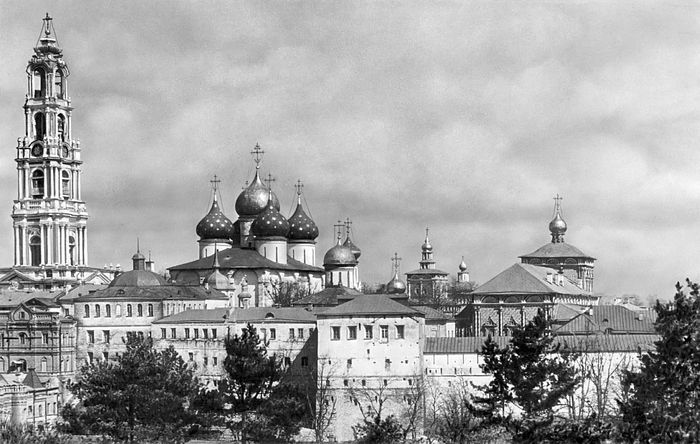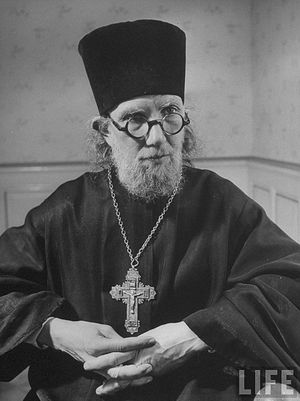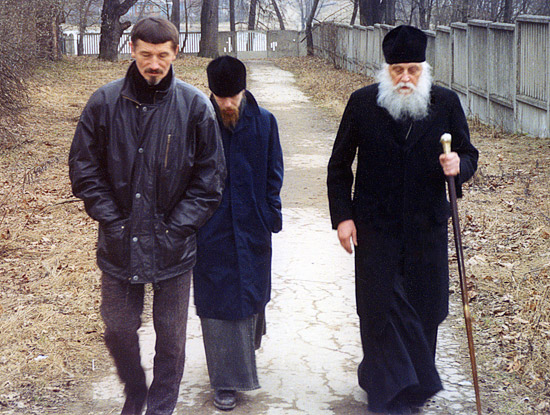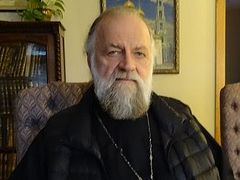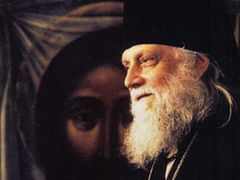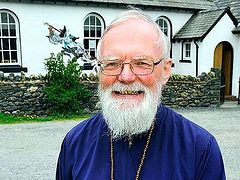My interviewee has had an extremely interesting and unusual life for an American woman. Charming, intelligent, she looks some 15 years younger than she really is. And behind her there is a long life full of the hard labors of a noble, self-sacrificing person who seeks to see Divine providence in every turn of her life. Here she is: secretary of Bishop Basil (Vasily) Rodzianko, assistant to Metropolitan Jonah (Paffhausen), an expert in the Russian literature and arts, honorable parishioner of the Cathedral of St. Nicholas the Wonderworker, Marilyn Pfeifer Swezey.
—Marilyn, how did you happen to get interested in Russia, in our country’s art?
—In the 1960s as a young woman I studied at a small Catholic college for women in New York. I studied classical art. Apart from the compulsory program we were to choose some optional subjects. I did not know why but I chose the Russian language course. That was the starting point for all the subsequent events in my life.
—The paths we choose… Did you enjoy learning Russian?
—Yes, I had a wonderful teacher—Olga Constantinovna Voronova (1894-1981), former lady in waiting to the empress. She was a daughter of the councilor of state and master of the hunt of the court of His Imperial Highness, Count Constantine Petrovich Kleinmichel and Yekaterina Nikolaevna Bogdanova—the daughter of the marshal of the nobility of Kursk province.
Olga Constantinovna’s husband, Pavel Voronov, a navy officer, served on the imperial yacht, the Standart, with the royal family for four years. The blessed memories of his service with the royal family remained with Pavel forever. The little Tsarevich Alexei loved him dearly—once the empress told Olga Constantinovna that the tsarevich used to keep her husband’s photograph at his bed. And, undoubtedly, Pavel Voronov was entirely devoted to the boy.
Olga Constantinovna testified: “I think it was impossible not to come to love this child who, besides his natural charm, gained the hearts of everybody by his kindness, his sympathy for others’ troubles—he was always the first to help and console—and by the patience with which he endured his illness, which at times made him a real sufferer.”
Before the departure of Pavel Voronov to war the Grand Duchess Olga gave him and Olga Constantinovna icons—one icon for each of them. From that day on they always had these icons with them—it was the only material remainder of the royal family that the couple managed to preserve during the years of the Revolution.
—Let me cite you several extracts from the reminiscences by Olga Constantinovna:
In January 1917 my husband began to have heart problems and he was returned from the front to St. Petersburg, or Petrograd, to be more exact. After the council of physicians at Maritime Hospital he was sent for two months to a spa resort in the Caucasus for treatment. Before our departure we were invited by the Empress to spend an evening together with her and the children. I had not seen them for a while and found a great change in Grand Duke Alexei. When I had visited the palace the previous time, the empress received me in one of its nurseries and the Tsarevich was delivered there to his bed. At the time he was recovering from a fit of his terrible disease and looked very pale and thin. All tried to cheer him up, and it was so moving to see the tender love with which his sisters played with him and cared for him. The Tsarina was knitting something for the Committee of temporary assistance to wounded soldiers headed by Grand Duchess Tatiana; from time to time she smiled to her son, though her look remained sad and anxious.
But I had never seen Grand Duke Alexei in such good shape before. He had grown up appreciably, transparency disappeared from his face, he had ruddy cheeks and looked absolutely healthy. Every time when the empress looked at him, a happy radiant smile lit up her face. The Tsarevich stayed near her all the time, sometimes kissed her face and hands, stroked her hair. This scene of the close, united, happy family remained in my memory forever. I was seeing them thenfor the last time.
The Nativity and New year of 1918 went of without joy, but quietly. I was melancholy but very delighted to receive a letter from Grand Duchess Tatiana in Tobolsk, Siberia, where the imperial family had been exiled…
Two days before the murder of the royal family, a priest was allowed to celebrate a Divine Liturgy in their prison (they had been deprived of such a consolation for a long time). Later he remembered how much he had been impressed by the depth of their spirit and the spiritual level the royal family had reached. He said he felt that they did not belong to this world any longer…
The memory of them will always support me on the path I have been walking in my life.”
—Yes, Olga Constantinovna was a wonderful person. She spoke such beautiful Russian… Her English was fluent and with a slight accent, and her French was excellent.
Our college was small, and the girls who learned Russian in the group numbered only six or seven, so we had a close communication with our teacher. Not only did Olga Voronova teach us Russian, but she also taught culture and history, especially the history of the Imperial court. And she loved the royal family—sincerely, faithfully. She passed this love on to us! I began to feel that the royal family became very close to my heart as well, as if I knew them personally! Later I gave my own children the names of the Holy Royal Martyrs.
And this is all thanks to Olga Constantinovna! Then I did not very clearly understand what a person I had met by Divine providence. I came to understand it later, after many years… Olga and Pavel Voronov were genuine Orthodox people. My acquaintance with Orthodoxy began precisely through them.
The stories of Olga Constantinovna about Orthodox Russia contained such a beauty and spiritual depth, that I wanted to become familiar with this country.
—And did you succeed in this?
—Oh, yes! After being taught for a year by Olga Constantinovna, I set off travelling around Europe and spent three weeks in Russia. Russia and America were officially enemies, but the Russian common folk turned out to be such open-hearted people. I visited Leningrad, Moscow, Kiev… When I came to Moscow, I was a Protestant. But that trip changed my life radically!
—What happened to you in Russia?
—I travelled with my friend. We were both aged 19. Now, when we freely travel from Russia to the USA and back, it is hard to imagine what an unusual experience it was for two American young ladies to travel to the USSR in the 1960s… My friend’s parents recommended us to visit a Catholic priest in Moscow. There were few of them in the capital—only for English-speaking and French-speaking diplomats.
I remember Fr. Louis Dion very well. He served at a chapel attached to the embassy in Moscow. And he advised us that we should visit the Holy Trinity-St. Sergius Lavra. He said it was necessary for us to do it. He explained us the route. So we took a suburban train to Zagorsk, now Sergiyev Posad. There were four of us. I could speak little Russian, while all my companions did not know a word of it. The stations flew past the window and the train hurried through the little Russian halts. We thought, how do we know when it’s Zagorsk?
I asked an elderly woman, a babushka, who was sitting next to me, and she understood me and replied: “Of course, I will let you know. Don’t worry!” And she told us the right station. We alighted and found ourselves alone on a platform with no people around. Then we saw a handsome young officer nearby. He gave us a smile and I asked him in broken Russian, “How can I get to the monastery?” He answered, but I understood only half of what he said.
We started our way and were soon helped. We met a young man who led us up to the monastery’s gate. We looked around and saw amazing churches. I will remember forever the moment we entered the Holy Trinity Cathedral—I found myself in another world! Then I knew nothing of Venerable Sergius of Radonezh…
There was nobody inside the church, except for a hieromonk who was reading an akathist to St. Sergius. We stood for a long time, listening to prayer, which was heard in total silence. I began to feel that wonderful atmosphere, which was not of this world. There was deep love and warmth. Peace. It was a gift of the Holy Spirit.
At that time I was already aware of the persecutions against the faithful in the Soviet Union, of the repressed and murdered clergy, of those who were left to rot in jails and mental hospitals. And—such beauty of Orthodoxy!
I don’t know how, I thought by myself there, before the relics of St. Sergius: “If I have an opportunity to help the faithful in Russia, then I must become Orthodox.” At that moment it was just in my thoughts. And even these thoughts were odd for a young American woman. It was many years later that I came to understand that St. Sergius heard my thought, my desire and helped it to come true.
—And how did it happen?
—At first I decided to master my Russian and to study the Russian literature and history more thoroughly. After four years at college I enrolled in a two-year course at Harvard University. We studied Russian history, Russian literature; it was Prof. George Florovsky who gave us seminars. There were only 20 students in our course, which was very intensive. We read War and Peace by Leo Tolstoy, compared the legal systems of the USSR and America. Two years later I received a Master of Arts degree. We were trained as specialists who would work for the American government and they were going to offer me a job. Pending the invitation, I went to visit my parents, and soon I indeed received an invitation, but it was not a job offer—it was an invitation to the annual dinner party at Harvard University. My year of graduation was 1965—it was the year when women first acquired degrees at Harvard. That invitation was obviously God’s Providence for me, because it was at that dinner party that I met my future husband Robert Swezey.
On the day of our engagement I finally received an invitation for work for the U.S. government in Washington, but it was too late: I was going to get married and live with my husband in Chicago and so could not work in Washington.
Although we did move to Washington with my husband—only four years later. It was there that I met Vladimir Tolstoy. We talked about Russia with him and everything at once came alive in my memory: the dreams, desires and prayer before St. Sergius’ relics. When Vladimir invited me to join the Christian Committee in Defense of the Rights of Persecuted Orthodox Christians in USSR, I accepted it without hesitating.
—What can you say about the work in that Committee?
—The Committee’s chairman was Archpriest Victor Potapov, and I worked as its secretary: I helped, translated materials, organized meetings, and prepared articles for publication in defense of the persecuted. We gave coverage to cases of persecution of believers, raised and sent money, wrote protests to the Soviet embassy, did our best to inform the world public of the persecutions against the faithful in USSR. I think my trip to the Holy Trinity-St. Sergius Lavra was the crucial moment in choosing my path of life.
One day Vladimir Tolstoy asked me to become a godmother to his son Nikolai. And I answered: “But I am not Orthodox.” He said in reply: “So the time has come for you to become Orthodox!”
Maria Potapova, wife of Archpriest Viktor Potapov, was an active member of the Committee. She was the only Orthodox woman I knew at that time and so I asked her to be my godmother. She introduced me to her uncle, Bishop Basil (Rodzianko).
In 1981, Bishop Basil received me into the Orthodox Church. And I became one of those who were concerned for Orthodox Russia with all their hearts. The Lord provided meetings with wonderful people for me, and it was the grace of God for me. I also became the secretary to Bishop Basil (Rodzianko) in 1981 and remained such until his repose in 1999. He introduced me to the world of Orthodoxy.
The bishop was experiencing material difficulties and I wrote a letter to my father: “Dad, could you possibly help Bishop Basil?” And in 1986 my father bought a flat for him where he lived and worked all his subsequent years. And this is the very flat—which later became a museum—where you and I are now.
—And what did your parents think of your work and Orthodoxy?
—My parents were cradle Catholics but as the years went by they became Protestants. They were surprised with the path of life I chose and could not understand why they had such a “Russian” daughter! But they loved me very much and trusted my choice. Dad met with my dear teacher—Olga Voronova—and was deeply impressed.
Once, during one of my trips to my parents’ home in Florida, I advised them to have their house blessed according to the Orthodox rite—to call for an Orthodox priest, to celebrate a prayer service… My parents had no objections. At that time Bishop Basil was staying in Florida, too. I called him and he along with Fr. Michael blessed my parents’ house together with my parents themselves, as they were celebrating their golden wedding anniversary.
My father was very impressed by the blessing of the house. He was moved by it and told me: “This was like a baptism of our house!”
A month later my father had a heart attack; he was 75. I believe it was the Lord Who had given me the idea to have my parents’ house blessed, because my father was thus prepared for what was to happen with him soon afterwards, during his illness. And this is what happened to him: he became Orthodox!
I asked him at hospital: “What if I invite an Orthodox priest, Fr. Michael, who together with Bishop Basil blessed your house?”
And my dad agreed! He was received into the Orthodox Church, took Communion and six hours later passed away. He reposed in the Lord very peacefully. I was at his bedside and saw his eyes shining with joy! Before the end he seemed to have seen someone near him—and his eyes began to shine! He wanted to greet joyfully the one whom he saw at the final moment of his life. Then he had another sigh—and passed on.
I think Bishop Basil prayed for him. Mom wanted that a funeral service be performed for dad in Washington. She knew she would move there to live close to me. And Bishop Basil performed a funeral service for him.
—Did your mother become Orthodox as well?
—A wonderful story happened to my mom as well. Several years after my father’s death, also at the age of 75, she was taken to the hospital. A surgical operation on her stomach followed, with liquid in the lungs, and a grave condition… I asked her permission to call the same priest, Fr. Michael, and she agreed. Inspired by my father’s example, she too became Orthodox and took Communion. Fr. Michael, looking at her after Communion, said, “Your mother is like a flower which suffered from drought and now feeling the influence of life-giving water!”
Indeed it was so, and one could even see it with physical eyes—not only spiritually. After Communion mother began to feel better at once. An instantaneous relief! I believe Bishop Basil prayed for my mother as well.
Soon she was discharged from the hospital and lived for twenty-one more years, reposing at the age of 96. And all those years she was an active parishioner of the Orthodox Church! And one more amazing thing! Bishop Basil continued to care for my parents even after their death! My father died in 1990 and was buried in the cemetery, in that part of it which belonged to the St. Nicholas Church. When the bishop reposed, the cathedral provided him space there and so he was buried next to my father’s grave. My mother was buried beside them.
I feel the providence of God, telling you all this, Olga! One thing follows another! Everything is interconnected!
—Yes, Marilyn, I feel this too. Your story touches me to the heart!
—My father’s Orthodox name is Vladimir, my mother’s is Elisabeth.
—Eternal memory to Vladimir and Elisabeth!
Marilyn, can you tell us about your years spent near Bishop Basil?
—You must know that he hosted programs for the faithful in Russia on the BBC. I recorded his sermons and helped him with everything. He was also my spiritual father. He led me to the Orthodox way of life, because Orthodoxy is a way of life!
Every piece of furniture in this flat, except for these chairs, was brought here by the bishop from London. The flat is relatively small, but he arranged here a home church, a bedroom, and an office. Bishop Basil was very tall and used to sleep on a folding bed with his legs partly in the corridor… The kitchen was tiny but meals were arranged there regularly, and all visitors were accommodated with love. This flat reflects his way of life. It looks very simple, but it is filled with “treasures”: relics, writings of sermons, icons…
Many of the icons were painted in London by Tamara Elchaninova (widow of the famous Russian Orthodox priest and spiritual writer Fr. Alexander Elchaninov: 1881-1934, who emigrated to France). The bishop related that T. Elchaninova would spend summers in the 1960s with their family and painted these icons.
A cross is kept in the altar of the home church. This is the cross from the grave of the bishop’s wife (she was his wife when he was a priest). She was a very talented choir director, and she led the choirs of all the churches where he served.
Bishop Basil had been a married priest for many years. His wife died in 1978, and in the following year he became a monk. Then he was invited to the USA where he was raised to the rank of archimandrite, and then consecrated a bishop. It was the first and (to date) the only consecration of a bishop at the St. Nicholas Cathedral.
There is a story associated with each photograph and each item in this flat. Here is the photo of the bishop’s grandfather, Michael Rodzianko, chairman of the Russian State Duma of the third and the fourth convocations (1911-1917). Here is photo of two grandsons who live in England. This is his niece, Mother Marina, who became a nun in Jerusalem. She is elder sister of Maria Potapova, the wife of Archpriest Victor Potapov. Maria Potapova is my godmother. Do you see how all is interconnected?
Metropolitan Jonah (Paffhausen) weekly serves a Liturgy in the house church. Now I am helping Metropolitan Jonah—it appears that Bishop Basil has “passed” me on to him. When Metropolitan Jonah serves here, Bishop Basil invisibly serves too because he is spiritually with us. The people who never saw Bishop Basil come here, feel his presence and get moved, tears began to flow and you do not know why…
 Thanksgiving Day: Metropolitan Jonah (Paffhausen), his mother (on the left), Olga Rozhneva (in the middle), Marilyn Swezey (on the right).
Thanksgiving Day: Metropolitan Jonah (Paffhausen), his mother (on the left), Olga Rozhneva (in the middle), Marilyn Swezey (on the right). —Do you feel spiritually connected with Bishop Basil?
—Beyond a doubt! I feel his support! He is like a part of my mind!... I feel his presence when I pray and always understand his answer. He helps, comforts…
I had two surgical operations in 1994 and 2006 and asked for his prayers so that the operations would go well and not be too painful. And both operations went very well!
The bishop had a spiritual intuition, a pastoral intuition. He opened an opportunity for me to sense the other world—the spiritual world. Here, in the West, people do not understand this; awareness of the spiritual world is not characteristic of the Western way of thinking, it was lost centuries ago. When the bishop received me into the Orthodox Church on the feast of Annunciation, 1981, I began to feel a new, spiritual dimension beside me which had not existed for me before. He developed in me the awareness of this inner, spiritual dimension.
Bishop Basil experienced many miraculous events in his life and he used to share them with me. He and his wife deeply venerated St. Seraphim of Sarov. In Yougoslavia bishop Vasily, then still Fr. Vladimir, was arrested by the Communists and sentenced to eight years in prison. In jail he once was very exhausted, despondent and fell asleep without prayer for the first time in his life. And in a dream he saw St. Seraphim of Sarov who consoled him and said that his situation would improve soon.
Fr. Vladimir wrote this to his wife and the latter was very surprised as she was praying for her husband to St. Seraphim of Sarov, felt his presence, and the saint predicted her speedy help. And Fr. Vladimir was released after two years instead of eight!
The bishop was a very intelligent man and highly educated; he was versed in European languages. He knew English, French, and some German. He had a beautiful voice. In 1955 he was looking for a job and so he offered to the BBC: “I am a priest and I wish to do programs for believers.” He was answered: “No, programs for believers are not a part of the BBC policy.” But he changed this policy! Already after the first program a great number of letters were received from around Russia! And people thanked him!
—Was Bishop Basil a strict spiritual father?
—The bishop used to say: “A loving father is he who finds a path appropriate for each spiritual child.” And his attitude to each person was defined by their spiritual strength, understanding the context of one’s life. He possessed an excellent pastoral intuition in understanding the people who came to him.
One of those people was Bishop Tikhon (Shevkunov). I first met him when he was still a layman, a graduate from the Gerasimov Institute of Cinematography called Gosha (a diminutive form of Georgy) Shevkunov. He also visited us as an archimandrite, while Bishop Basil was still alive. He also came several years ago with his book, Everyday Saints and Other Stories, translated into English.
I love his book very much! And love Bishop Tikhon himself. He is an extraordinary man. He was born to perform great deeds in the life of the Church.
Let me tell you this interesting story. Regarding the link between the spiritual world with our world.
When Bishop Tikhon visited the previous time, still as an archimandrite, I wanted to give him something to remember Bishop Basil by. I am in charge of Bishop Basil’s archives, and I thought, “What will I give him as a present?”
I looked around in this flat-museum. I could give him an icon, a book, a photograph, any of the relics. But suddenly I felt something, as if Bishop Basil himself told me: “Give him my bishop’s miter.”
I came up to the wardrobe in which several bishop’s miters were stored. I chose a dark red one which was the most beautiful: Bishop Basil loved it and wore it often. And I gave it to Fr. Tikhon. He put it on. He could have worn it before, as an archimandrite, but nevertheless it was a bishop’s cap which had belonged to Bishop Basil…
—Maybe you can remember any other episode from Bishop Basil’s life that you witnessed?
—One day Bishop Basil learned that his sister who lived in Russia was dying of liver cancer. He wanted to see her for the last time very much and tried to get a visa to Russia. But he was refused a visa for four times. At that time the Madrid visa treaty was signed: in case of an illness of family members visas were granted. I was aware of this and wrote a complaint against the violation of the treaty.
Two weeks passed and I was called from the consulate—they suggested I make an appointment with the ambassador Anatoly Dobrynin (1919-2010). I called to the USSR embassy and told them the bishop’s surname. “Oh, Rodzianko?” I heard the reply, and I was at once put through to the ambassador. This seemed impossible, but it did happen. The ambassador made an appointment through me as the bishop’s secretary.
And so I took Bishop Basil from New York where a meeting of the Synod was then beginning. When we approached the embassy I started looking for a parking lot, and the bishop asked me, “Will you join me? I do not want to go there alone.” “Sure,” I answered.
And we entered the embassy. The embassy workers saw the bishop: tall, with his fluffy white beard, in full monastic clothing: a cassock, black klobuk and veil, and was wearing a large panagia. He was a true Russian bishop!
 The USSR ambassador to the USA Anatoly Dobrynin, First Deputy Minister of USSR Foreign Affairs Vasily Kuznetsov, and the US President John Kennedy (from left to right).
The USSR ambassador to the USA Anatoly Dobrynin, First Deputy Minister of USSR Foreign Affairs Vasily Kuznetsov, and the US President John Kennedy (from left to right). We were led to the ambassador. Anatoly Dobrynin served as the USSR ambassador to America for 24 years: over that time five General Secretaries succeeded each other in USSR and in the USA—six presidents. Dobrynin was an extraordinary figure and he played an important role in the resolution of the Cuban Missile Crisis along with stabilization of relations between the Soviet Union and the USA. He met us and cordially greeted the bishop; the latter introduced me to him and I became a witness of this historic conversation.
They spoke in Russian for about an hour. Dobrynin said to the bishop: “I feel certain you will not do anything in the USSR we don’t want you to do.” He also said: “My mother was a believer. She always blessed me when I returned to Russia from America. And she prayed for me. But now she is dead.”
The bishop replied, “She is still praying for you in heaven.” A pause followed. It lasted several moments. The ambassador’s face completely transformed. It was clear that the bishop’s words impressed him very much. Dobrynin was silent for some time and then pronounced in a changed voice, “Of course, I will grant you a visa.” And he personally gave the bishop a visa. It was evident that the words of Bishop Basil touched him deeply.
I was looking at these two mighty Russian men. And one of them really was stronger. I think the bishop was stronger.
—Were you together with the bishop until his final days?
—On the evening of September 16, 1999, I saw him alive for the last time. We drank tea together and talked. In the following morning I came back to him with the view of accompanying him to the migration service for the American citizenship ceremony (this event is usually fixed a month before). But by that moment he had already been granted another citizenship—the heavenly one. At night he had a stroke and died.
—Bishop Tikhon (Shevkunov) wrote a preface to the book by Bishop Basil, My Life. Reminiscences. I would like to cite a few words by Bishop Tikhon from that preface:
On September 17, 1999, Russian Bishop Basil (Rodzianko) reposed in Washington. The bishop had reached the hour from which he would embark on a journey for which he had been seriously preparing all his life… He was a true bishop and master (in Russian: ‘vladyka’)! Indeed he infinitely ruled over human souls. His unforgettable and inimitable kindness, faith and love were his indestructible and wonderful power that even today reaches over those who were vouchsafed to know Bishop Basil personally.
Thank you for your marvelous talk, dear Marilyn! What would you say in conclusion to our website’s readers?
—May the Lord help and keep you, my dears!




